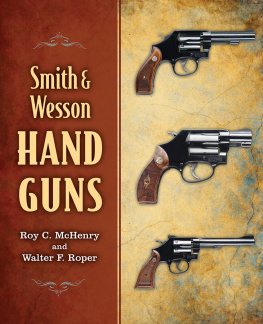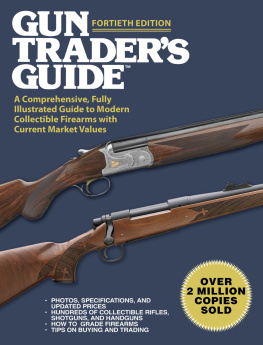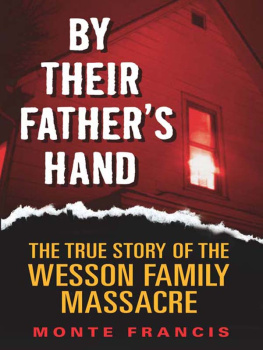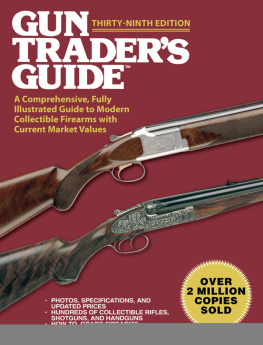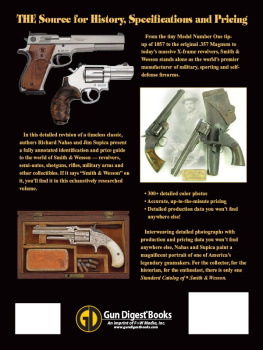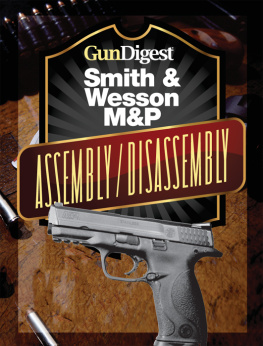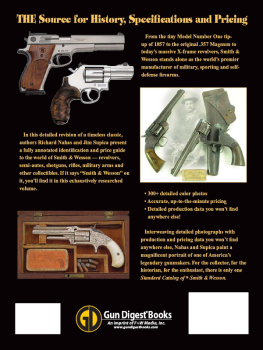SMITH & WESSON
HAND GUNS
This special edition of
SMITH & WESSON
HAND GUNS
by ROY C. McHENRY
and
WALTER F. ROPER

Copyright 2013 by Roy C. McHenry and Walter F. Roper All Rights Reserved. No part of this book may be reproduced in any manner without the express written consent of the publisher, except in the case of brief excerpts in critical reviews or articles. All inquiries should be addressed to Skyhorse Publishing, 307 West 36th Street, 11th Floor, New York, NY 10018.
Skyhorse Publishing books may be purchased in bulk at special discounts for sales promotion, corporate gifts, fund-raising, or educational purposes. Special editions can also be created to specifications. For details, contact the Special Sales Department, Skyhorse Publishing, 307 West 36th Street, 11th Floor, New York, NY 10018 or info@skyhorsepublishing.com.
Skyhorse and Skyhorse Publishing are registered trademarks of Skyhorse Publishing, Inc., a Delaware corporation.
Visit our website at www.skyhorsepublishing.com.
10 9 8 7 6 5 4 3 2 1
Library of Congress Cataloging-in-Publication Data is available on file.
ISBN: 978-1-62087-715-9
Printed in China
EDITORS NOTE

ROY C. McHENRY AND WALTER F. ROPERS
SMITH & WESSON HAND GUNS

by Dr. Jim Casada
Handgun collectors actively seek McHenry and Ropers Smith & Wesson Hand Guns and gladly pay 20 times the original published price for this basic reference. Thus does M. L. Duke Biscotti, in his important reference work American Sporting Book Series (1994), describe the significance of the book presently being reprinted. Biscotti goes on to say, Anyone wanting to collect this firearm makers guns will need a copy of this work. Similarly, another standard reference tool for gun collectors and bibliophiles, Ray Rilings Guns and Shooting: A Bibliography (1982), says this is the story of Smith & Wesson and praises the book as the first work to attempt a comprehensive coverage. Today, better than half a century after its original appearance, the work remains the source for Smith & Wesson enthusiasts, although serious students of the handguns are also indebted to John E. Parsons for his Smith Wesson Revolvers (1957) and to numerous articles that have appeared in The American Rifleman over the years by authorities such as Herschel Logan, Carl Kountz, Colonel B. R. Lewis, and Colonel R. C. Kuhn.
The story of Smith & Wesson handguns and their evolution is one of the hallowed tales of American firearms history. In the words of Dr. James E. Byrne, the success of Smith & Wesson was born of failure. In the 1850s, Horace Smith, a talented if unknown Massachusetts gunsmith, linked his talents (and as matters proved, destiny) with those of Daniel B. Wesson, a brother of the inventor of the Wesson & Leavitt revolver, Edwin Wesson. Their creativity and ingenuity soon resulted in a variety of important firearms patents and eventually led to the development of the modern cartridge revolver. All of the early Smith & Wesson pistols were much sought after, and, as Byrne says, the popularity of the Smith & Wesson rimfire revolver was loudly attested by their agents inability to supply the public demands. Accordingly, it should come as no surprise that those same handguns are now prized collectors items and that Smith & Wesson Hand Guns is the bible of these collectors. It is an authoritative reference source and has remained, for a full five decades, the cornerstone upon which Smith & Wesson research rests.
What the work does, in essence, is offer the reader a primer, with the support of 63 lavish illustrations showing the handguns, the unique hammer mechanism, and facsimile reproductions of vintage advertising copy. Perhaps the most used section of the book is that which gives detailed descriptions of the various models. This section, a sort of identification road map, carries the reader or handgun owner through the often confusing welter of gun marks, patent numbers, and other characteristics appearing on the firearms. Valuable as this identifying information is, however, the 24 chapters of the book covering the handguns and their history should not be overlooked. Indeed, they are must reading for the serious Smith & Wesson student.
It would appear, from such biographical information on the coauthor as is available, that writing and publication of Smith & Wesson Hand Guns resulted from the ideal combination of collector interest and first-hand expertise. Roy C. McHenry, the first author, was the possessor of a fine collection of handguns and undoubtedly knew a great deal about them and the Smith & Wesson story. But when it came to real handgun expertise, he took a distinct second position to his coauthor, Walter F. Roper.
Some indication of Ropers knowledge is given by his other literary endeavors connected with handguns. In addition to the present work, he wrote Pistol and Revolver Shooting (1945; this book places particular emphasis on target work and ballistics) and Experiments of a Handgunner (1949). The latter work gives details of researches (most undertaken by Roper himself) with targets, stocks, rests, handloading, and related subjects. Many of these experiments first saw the printed light of day in The American Rifleman. Ray Riling calls Experiments of a
Handgunner an excellent work for the serious handgunner, and the book was at that time a National Rifle Association Library selection.
Further evidence of Ropers importance in the field can be found in comments scattered throughout Colonel Charles Askins The Pistol Shooters Book: A Modern Encyclopedia (1953). Although Askins tended to be opinionated and was sometimes irascible in the best tradition of gun scribes, he was, on the whole, clearly a Roper fan. He mentions in his book Ropers work in designing a single .22 revolver, the Sportsman Model 999, for the Harrington and Richardson Arms Company during the 1930s. Askins liked the guns stock (custom stock making was a specialty of Ropers) and its grip but found that its lack of weight and a muzzle light feeling made it difficult to shoot successfully. Apropos of gun grips and handgun stocks, most of the great handgun target shooters of Ropers generation were indebted to him in this regard. Askins puts it quite simply: The best custom grips are made by Walter Roper and by Lew Sanderson. Roper has been making handgun stocks for almost 20 years and is a past master at the art, he is an engineer and an enthusiastic shooting man as well as an author on pistols. Other areas in which Roper did a lot of work as a gunsmith included sights and fitting shooters with spectacles that allowed them both to have good distance vision and to focus on the gun sights.
In short, Roper in all likelihood had the requisite skills and knowledge needed to produce this book on his own. He was a fine marksman, an authority on handguns, a skilled gunsmith, an engineer, and, like the subjects of whom he would write, an innovator. However, he probably lacked the vital historical perspective necessary to make the book a well-rounded one, and that is precisely what McHenry, the collector and student of firearms past, brought to the undertaking.
The end product of their coauthorship was a handsome one indeed. Modern readers can be thankful that the two men turned to Herman P Deans Standard Publications, Inc., as the books publisher. Dean, a devoted student of the literature of guns and sport, was the owner of an extensive library in these fields. A newspaper proprietor by profession, he had an ideal background to establish a press dedicated to producing high-quality firearms and hunting books, and with considerable encouragement from another bibliophile with similar interests, Ray Riling, he launched his publishing venture in 1941. Most of his books were highly specialized, and many had small press runs.

